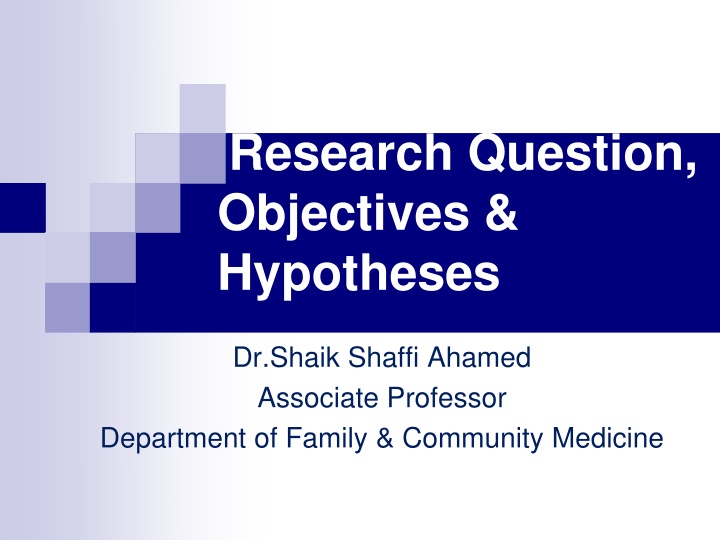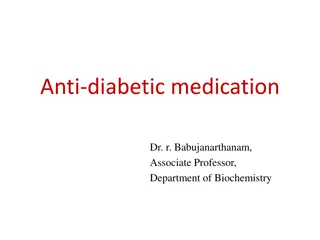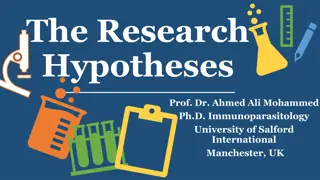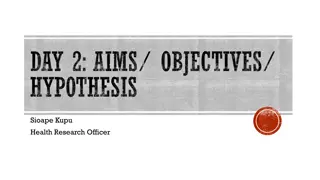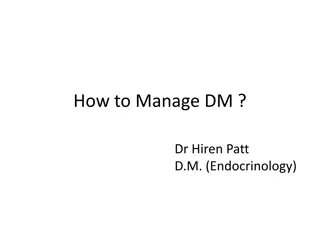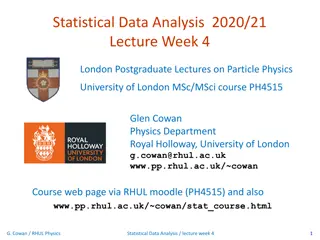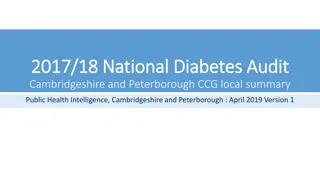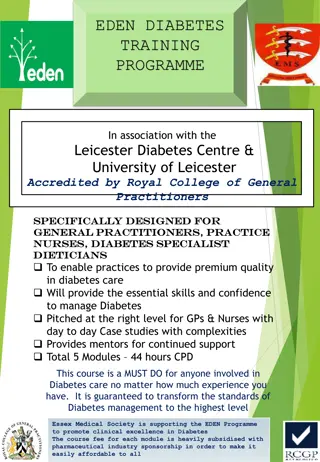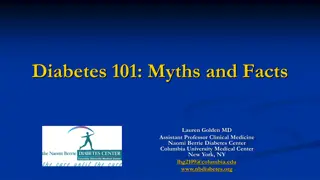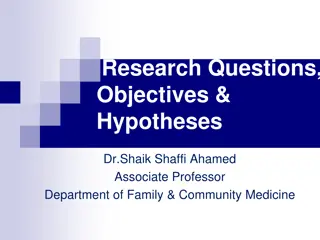Research Questions, Objectives, and Hypotheses in Diabetes Management
Explore the formulation of research questions, setting study objectives, and defining hypotheses in the context of diabetes mellitus management. Delve into the prevalence of diabetes in Saudi Arabia, glycemic control in diabetic patients, and addressing key research questions to reduce the impact of diabetes in the region.
Download Presentation

Please find below an Image/Link to download the presentation.
The content on the website is provided AS IS for your information and personal use only. It may not be sold, licensed, or shared on other websites without obtaining consent from the author.If you encounter any issues during the download, it is possible that the publisher has removed the file from their server.
You are allowed to download the files provided on this website for personal or commercial use, subject to the condition that they are used lawfully. All files are the property of their respective owners.
The content on the website is provided AS IS for your information and personal use only. It may not be sold, licensed, or shared on other websites without obtaining consent from the author.
E N D
Presentation Transcript
Research Question, Objectives & Hypotheses Dr.Shaik Shaffi Ahamed Associate Professor Department of Family & Community Medicine
SESSION OBJECTIVES Students will be able to 1. Learn formulation of research question 2. Differentiate between goals & objectives 3. Define the specific objectives in terms of the stated problem 4. Describe the study hypotheses 2
Ref: Prevalence of diabetes mellitus (DM) in a Saudi community. Ann Saudi Med. 2011 Jan-Feb;31(1):19-23 3
Glycemic control in diabetic patients KKUH January December 2009 Al-Rowais NA Saudi Pharmaceutical Journal (2014) 22, 203-206 % HbA1C < 7% is acceptable as adequate control 4
What research questions come to your mind? How to reduce the prevalence of DM? How to increase, well controlled HbA1c? What other research questions can arise ? All the stated responses will lead towards the goal of reducing the impact of DM in Saudi Arabia and each research question will be answered by stating clear objectives 5
Ask following questions initially Do I have, time for this topic at this point during my course? Is this really the burning topic for me? Will this be worth it? Is this a major and relevant public health problem or is it too mysterious? Are my goals/objectives too big ? Am I covering too much? Will available methods answer my questions? What are the ethical and human subject issues here? 6
Research Question A well-defined and specific research question is the key for making decisions about study design and population and subsequently what type of data will be collected and analyzed. 7
RESEARCH QUESTION IT SHOULD BE A SINGLE SENTENCE IN THE FORM OF A QUESTION. IT SHOULD BE CLEAR, UNAMBIGUOUS AND SPECIFIC
What is a Research Question? Often begins with a general concern Examples: Should women take hormones to prevent bone loss? Can a vegetarian diet reverse cardiovascular disease? Can diabetic patients be taught to control their blood glucose levels?
What is a Research Question? Must be narrowed to measurable and can able to do research Examples: Is taking estrogen associated with a lower risk of osteoporosis in women 60+? Does a plant-based diet reduce serum cholesterol levels in patients with cardiovascular disease? Can a structured intensive diabetes education program help patients with type 2 diabetes control their blood glucose levels?.
How & from where to get ideas to formulate a Research Question ? Be inspired by observing people & practices, by attending seminars, conferences, & symposia Review local, national, and regional problems Discuss, collaborate and get input from your colleagues Read about the topic, reviews, & research done; to find out gaps in existing knowledge? 11
REQUIREMENTS What are the items required to support feasibility of my research question ? Your background knowledge reflects in the question Background information (critical appraisal) stated in intro/background section 12
Subject knowledge Familiarity with the subject helps define an appropriate research question for a study. Questions arise out of a perceived knowledge deficit within a subject area or field of study. (pathways of current knowledge and uncertainty ) The challenge in developing an appropriate research question, is in determining which uncertainties could or should be studied and also rationalizing the need for their investigation. 13
What goes in the research question? Disease or condition of interest Population Intervention to be tested Comparison group(s) -- placebo? Existing treatment? Outcome measures
Sample research question Interest: Should women take hormones to prevent bone loss? Research question: Does taking estrogen after menopause reduce the likelihood of bone density loss in women over 60 years of age, compared to women not taking estrogen?
Sample research question Interest: Can a vegetarian diet reduce cardiovascular disease? Research question: Does an entirely plant- based (vegan) diet reduce blood serum cholesterol levels in men over 50 years old with lipid levels > compared to a meat- based diet?
Sample research question Interest: Can diabetic patients be taught to control their blood glucose levels? Research question: Can a structured intensive diabetes education program help adult patients with Type 2 diabetes control their blood glucose levels, compared to patients receiving standard instructions?
Types of Research Questions Descriptive: describing a group, exploring Relational: associations between two variables in a group Comparable: associations between two or more variables (differences) in two or more groups (Causality / prediction / intervention) 18
RESEARCH QUESTIONS(examples) What is the level of knowledge of Biostatistics among 3rd year medical students ? Is drug A better than drug B in the management of hepatic failure in patients with Cirrhosis? Is alcoholism related to the development of Cirrhosis liver?
Relational & Comparable Is concentration of blood cholesterol directly related to dietary intake of saturated fat in Saudi population? (hereditary?/ dietary/ metabolic ? Reasons in Saudi Population could differ from other settings) Does daily saturated fat intake by persons with hypercholesterolemia differ from persons with normal cholesterol range in Saudi population ? 20
Evaluation of Research Question How good and appropriate is the idea ? Critique appropriateness of your Question Merit of your question Relationship of proposal to problem 21
GOOD RESEARCH QUESTION Feasible: Interesting: Novel: Ethical: Relevant: 22
FINER criteria: a good research question F Feasible Adequate number of subjects Adequate technical expertise Affordable in time and money Manageable in scope I Interesting Getting the answer intrigues investigator, peers & community N Novel Confirms, refutes or extends previous findings E Ethical Amenable to a study that institutional review board (IRB) will approve R Relevant To scientific knowledge To future research To clinical and health policy 23
Goals and Objectives Goals Objectives =
Goals It describes the aim of the work in broad terms ( over a longer time period)
Objectives These are more specific and relate directly to research question. They may be divided into two types: Primary objectives (bound to be achieved) Secondary objectives (by the way)
Research Goal & Objectives The goal (aim) and objectives must be stated at the very beginning of the study, since they will guide the investigator during the process of formulating research questions and hypothesis. They will also help in the prioritization process. They will enable the reader or consumer of the work to judge whether the investigator had achieved these objectives or not.
Research Objectives The research objectives should be: Closely related to the research question Covering all aspects of the problem Very specific Ordered in a logical sequence Stated in action verbs that could be evaluated e.g. to describe, to identify, to measure, to compare, etc. Achievable, taking into consideration the available resources and time Mutually exclusive, with no repetitions or overlaps
SMART Objectives S Specific M Measurable A Achievable R Relevant T Time-bound
Research objectives Properly formulated, specific objectives will facilitate the development of your research methodology and will help to orient the collection, analysis, interpretation and utilization of data.
Objective -examples To study whether SNP markers are associated with obesity and hypertension phenotypes. To assess the general population knowledge & attitude towards Organ donation To identify the risk factors for Type-II diabetes
Example Goal: To reduce risk of cardiovascular diseases in Saudi population by developing evidence based interventions Question: Is dietary intake of saturated fats over the past xx weeks related to hypercholestrolemia in Saudi adult population ? Question: Is dietary intake of saturated fats over a period of xx months is associated with risk of coronary heart disease in Saudi adult population 32
Example contd. Objective1: To determine the daily intake of saturated fats in the past 4 weeks in Saudi adults Objective 2: To determine the relationship of dietary intake of saturated fats and blood levels of low density lipoprotein (LDL) in Saudi adults Objective3: To determine the association of dietary intake of saturated fats and intimal thickness of coronary artery in Saudi adults 33
Research Hypothesis Research hypothesis is a statement of the research question in a measurable form
Research Hypothesis (cont.) A hypothesis can be defined as a prediction or explanation of the relationship between one or more independent variables (PREDISPOSING/RISK FACTORS) and one dependent variable (OUTCOME/CONDITION/DISEASE)). A hypothesis, in other words, translates the problem statement into a precise, clear prediction of expected outcomes. It must be emphasized that hypotheses are not meant to be disorganized guesses, but should reflect the depth of knowledge, imagination and experience of the investigator.
Hypothesis formulation This is based on existing knowledge, deriving it through critical reading of literature and facts Descriptive: It is hypothesized that average daily intake of saturated fat in Saudi adult population is more than 20% of the recommended intake when measured by xxx test and yyy standards to define dietary saturated fat intake. 36
Hypothesis formulation Objective: To determine the relationship of dietary intake of saturated fats and intimal thickness of coronary artery Hypothesis It is hypothesized that > 20% of recommended saturated fat intake in Saudi population will be associated with 50% increased intimal thickness of coronary artery when compared to the normal intimal thickness measured by XYZ 37
Hypothesis-examples We hypothesize that standard care plus new intervention (additional drug) will be superior to standard care alone in reducing CVD mortality by 30% among patients with preexisting heart disease. We hypothesize that prophylaxis with inhaled drug A will be superior to oral preparation of drug B in preventing acute exacerbation of reactive airway disease by 20%. We hypothesize that low birth weight is an independent risk factor for type II diabetes.
Example 1: (KAP Study) Area: Community medicine Topic: Communicable diseases- hepatitis RQ: What is the level of KAP towards hepatitis among the general population of KSA ? Goal: To contribute to the reduction of hepatitis in KSA through studying general population perceptions about the disease Objective: To assess the knowledge, attitudes and practice of the general population towards hepatitis in KSA. Hypothesis: It is hypothesized that the knowledge attitudes and practice of the general population towards hepatitis in KSA is less than 50%.
Example 2 ( Cross sectional study) Area : Psychiatry Topic: Body Dysmorphic Disorders ( BDD) RQ: What is the prevalence of BDD among female medical students in Riyadh ? Goal: To contribute, by finding the prevalence of BDD and its associated factors in Saudi females Objective: To Quantify the prevalence of BDD among female medical students Hypothesis: It is hypothesis that, the prevalence of BDD among female medical students is around 10%.
Example 3: (Interventional Study) Research area: Cardiology Research topic: Ischemic heart disease (IHD) Goal: To contribute to prevention of IHD Research question: Does hypocholesterolemic agent A decrease the risk of MI? Primary objective: To determine the effect of reducing LDL on the occurrence of MI Secondary objective: To describe the side effects of lowering LDL Hypothesis: The risk of MI among patients treated with hypocholesterolemic agent A is lower than the risk among patients not treated with hypocholesterolemic agents
Summary Perform a systematic literature review to increase knowledge for the topic 1. Learn about current trends and advances on the topic. 2. Seek careful input from experts, mentors, colleagues and collaborators 3. Use the FINER criteria in the development of the research question. 4. Develop clear and well-defined objectives using SMART criteria 5. Ensure that the research question and objectives are answerable, feasible and relevant. 6. Develop the testable research hypotheses from the research question. 7. 42
References Stephen B Hulley. Designing Clinical Research. 3rd Edition . Wolters Kluwer Health Lippincott Williams and Wilkins 2007. Daniel P Schuster & William J Powers. Translational and Experimental Clinical Research. Introduction: Lippincott Williams and Wilkins 2005. Cummings SR, Browner WS, and Hulley SB. Conceiving the research question. In Hulley SB, Cummings SR, Browner WS, Grady D, Hearst N, and Newman TB. Designing Clinical Research. 2nd edition. Philadelphia: Lippincott Williams & Wilkins, 2001. Fletcher RH, Fletcher SW, Wagner EG. Clinical Epidemiology: the essentials. 3rd edition. Baltimore: Williams and Wilkins, 1996. Sackett DL, Haynes RB, Guyott GH, Tugwell, P. Clinical Epidemiology: a basic science for clinical medicine. 2nd edition. Boston: Little, Brown and Company, 1991. 43
